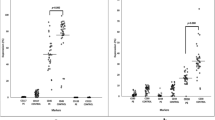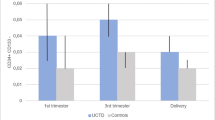Abstract
Purpose
Endothelial Progenitor Cells (EPCs) and Natural Killer (NK) cells were recently advocates in the pathogenesis of preeclampsia (PE), since they can be mobilized into the bloodstream and may orchestrate vascular endothelium function. The aim of our study was to evaluate in early pregnancy circulating EPCs and NK cells in peripheral blood in women who later developed PE compared to uncomplicated pregnancies.
Methods
We prospectively enrolled pregnant women at 9+0–11+6 weeks of gestation at the time of first-trimester integrated screening for trisomy 21, who underwent peripheral venous blood (20 mL) sample. We included only women who later developed PE (cases) and women with uncomplicated pregnancy (controls), matched for maternal age, parity, and Body Mass Index. In these groups, we evaluated the levels of CD16+CD45+CD56+ NK cells and CD34+CD133+VEGF-R2+ EPCs in peripheral blood samples previously stored.
Results
EPCs were significantly lower (p < 0.001), whereas NK cells were significantly higher (p < 0.001) in PE group compared to uncomplicated pregnancies during the first trimester.
Conclusion
The evaluation of EPCs and NK cells in peripheral blood during the first trimester may be considered an effective screening for the early identification of women at risk of developing PE.


Similar content being viewed by others
References
Tranquilli AL, Dekker G, Magee L et al (2014) The classification, diagnosis and management of the hypertensive disorders of pregnancy: a revised statement from the ISSHP. Pregnancy Hypertens 4:97–104. doi:10.1016/j.preghy.2014.02.001
Hutcheon JA, Lisonkova S, Joseph KS (2011) Epidemiology of pre-eclampsia and the other hypertensive disorders of pregnancy. Best Pract Res Clin Obstet Gynaecol 25:391–403. doi:10.1016/j.bpobgyn.2011.01.006
Roberts JM, Pearson GD, Cutler JA, Lindheimer MD (2003) Summary of the NHLBI working group on research on hypertension during pregnancy. Hypertens Pregnancy 22:109–127. doi:10.1081/PRG-120016792
Granger JP, LaMarca BB, Cockrell K et al (2006) Reduced uterine perfusion pressure (RUPP) model for studying cardiovascular-renal dysfunction in response to placental ischemia. Methods Mol Med 122:383–392
Tan MY, Wright D, Koutoulas L et al (2016) Comparison of screening for preeclampsia at 31–34 weeks’ gestation by the sFLT to PLGF ratio and a method combining maternal factors with sFLT-1 and PLGF. Ultrasound Obstet Gynecol. doi:10.1002/uog.17307
Laganà AS, Favilli A, Triolo O et al (2016) Early serum markers of preeclampsia: are we stepping forward? J Matern Fetal Neonatal Med 29:3019–3023. doi:10.3109/14767058.2015.1113522
Urbich C, Dimmeler S (2004) Endothelial progenitor cells: characterization and role in vascular biology. Circ Res 95:343–353. doi:10.1161/01.RES.0000137877.89448.78
Hubel CA, Sipos PI, Crocker IP (2011) Endothelial progenitor cells: their potential role in pregnancy and preeclampsia. Pregnancy Hypertens 1:48–58. doi:10.1016/j.preghy.2010.11.001
Lowe DT (2000) Nitric oxide dysfunction in the pathophysiology of preeclampsia. Nitric Oxide 4:441–458. doi:10.1006/niox.2000.0296
Aicher A, Heeschen C, Mildner-Rihm C et al (2003) Essential role of endothelial nitric oxide synthase for mobilization of stem and progenitor cells. Nat Med 9:1370–1376. doi:10.1038/nm948
Zhu J, Cheng X, Wang Q et al (2015) Transplantation of endothelial progenitor cells for improving placental perfusion in preeclamptic rats. Arch Gynecol Obstet 291:1113–1119. doi:10.1007/s00404-014-3522-z
Masuda H, Tanaka R, Fujimura S et al (2014) Vasculogenic conditioning of peripheral blood mononuclear cells promotes endothelial progenitor cell expansion and phenotype transition of anti-inflammatory macrophage and T lymphocyte to cells with regenerative potential. J Am Heart Assoc 3:e000743–e000743. doi:10.1161/JAHA.113.000743
Bonney EA (2016) Immune regulation in pregnancy. Obstet Gynecol Clin North Am 43:679–698. doi:10.1016/j.ogc.2016.07.004
Kieffer TEC, Faas MM, Scherjon SA, Prins JR (2017) Pregnancy persistently affects memory T cell populations. J Reprod Immunol 119:1–8. doi:10.1016/j.jri.2016.11.004
Laganà AS, Triolo O, Salmeri FM et al (2016) Natural Killer T cell subsets in eutopic and ectopic endometrium: a fresh look to a busy corner. Arch Gynecol Obstet 293:941–949. doi:10.1007/s00404-015-4004-7
Moffett-King A (2002) Natural killer cells and pregnancy. Nat Rev Immunol 2:656–663. doi:10.1038/nri886
Vacca P, Vitale C, Montaldo E et al (2011) CD34 + hematopoietic precursors are present in human decidua and differentiate into natural killer cells upon interaction with stromal cells. Proc Natl Acad Sci USA 108:2402–2407. doi:10.1073/pnas.1016257108
Riedhammer C, Halbritter D, Weissert R (2016) Peripheral blood mononuclear cells: isolation, freezing, thawing, and culture. Methods Mol Biol 1304:53–61. doi:10.1007/7651_2014_99
Bryceson YT, Fauriat C, Nunes JM et al (2010) Functional analysis of human NK cells by flow cytometry. Methods Mol Biol 612:335–352. doi:10.1007/978-1-60761-362-6_23
Rustemeyer P, Wittkowski W, Jurk K, Koller A (2006) Optimized flow cytometric analysis of endothelial progenitor cells in peripheral blood. J Immunoass Immunochem 27:77–88. doi:10.1080/15321810500403789
Matsubara K, Abe E, Matsubara Y et al (2006) Circulating endothelial progenitor cells during normal pregnancy and pre-eclampsia. Am J Reprod Immunol 56:79–85. doi:10.1111/j.1600-0897.2006.00387.x
Sibai BM (2005) Diagnosis, prevention, and management of eclampsia. Obstet Gynecol 105:402–410. doi:10.1097/01.AOG.0000152351.13671.99
Hur J, Yoon CH, Kim HS et al (2004) Characterization of two types of endothelial progenitor cells and their different contributions to neovasculogenesis. Arterioscler Thromb Vasc Biol 24:288–293. doi:10.1161/01.ATV.0000114236.77009.06
Leu S, Day Y-J, Sun C-K, Yip H-K (2016) tPA-MMP-9 axis plays a pivotal role in mobilization of endothelial progenitor cells from bone marrow to circulation and ischemic region for angiogenesis. Stem Cells Int 2016:5417565. doi:10.1155/2016/5417565
Gammill HS, Lin C, Hubel CA (2007) Endothelial progenitor cells and preeclampsia. Front Biosci 12:2383–2394
Hu Y, Liu X, Liu X et al (2016) Role of axl in preeclamptic EPCs functions. J Huazhong Univ Sci Technolog Med Sci 36:395–401. doi:10.1007/s11596-016-1598-3
Sugawara J, Mitsui-Saito M, Hayashi C et al (2005) Decrease and senescence of endothelial progenitor cells in patients with preeclampsia. J Clin Endocrinol Metab 90:5329–5332. doi:10.1210/jc.2005-0532
Parham P (2004) NK cells and trophoblasts: partners in pregnancy. J Exp Med 200:951–955. doi:10.1084/jem.20041783
Kopcow HD, Allan DSJ, Chen X et al (2005) Human decidual NK cells form immature activating synapses and are not cytotoxic. Proc Natl Acad Sci USA 102:15563–15568. doi:10.1073/pnas.0507835102
Molvarec A, Ito M, Shima T et al (2010) Decreased proportion of peripheral blood vascular endothelial growth factor-expressing T and natural killer cells in preeclampsia. Am J Obstet Gynecol 203(567):e1–e8. doi:10.1016/j.ajog.2010.07.019
Molvarec A, Blois SM, Stenczer B et al (2011) Peripheral blood galectin-1-expressing T and natural killer cells in normal pregnancy and preeclampsia. Clin Immunol 139:48–56. doi:10.1016/j.clim.2010.12.018
Fukui A, Yokota M, Funamizu A et al (2012) Changes of NK Cells in Preeclampsia. Am J Reprod Immunol 67:278–286. doi:10.1111/j.1600-0897.2012.01120.x
Heimrath J, Paprocka M, Czekanski A et al (2014) Pregnancy-induced hypertension is accompanied by decreased number of circulating endothelial cells and circulating endothelial progenitor cells. Arch Immunol Ther Exp (Warsz) 62:353–356. doi:10.1007/s00005-014-0278-x
Ribatti D, Moschetta M, Vacca A (2014) Microenvironment and multiple myeloma spread. Thromb Res 133(Suppl 2):S102–S106. doi:10.1016/S0049-3848(14)50017-5
Author information
Authors and Affiliations
Corresponding author
Ethics declarations
Conflict of interest
The authors declare that they have no conflict of interest.
Ethical approval
All procedures performed in this study involving human participants were in accordance with the ethical standards of the institutional and/or national research committee and with the 1964 Helsinki declaration and its later amendments or comparable ethical standards.
Informed consent
Informed consent was obtained from all individual participants included in the study.
Rights and permissions
About this article
Cite this article
Laganà, A.S., Giordano, D., Loddo, S. et al. Decreased Endothelial Progenitor Cells (EPCs) and increased Natural Killer (NK) cells in peripheral blood as possible early markers of preeclampsia: a case-control analysis. Arch Gynecol Obstet 295, 867–872 (2017). https://doi.org/10.1007/s00404-017-4296-x
Received:
Accepted:
Published:
Issue Date:
DOI: https://doi.org/10.1007/s00404-017-4296-x




